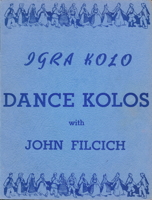
|
Folk Dance Federation of California, South, Inc.
|

|
CLICK AN IMAGE TO ENLARGE
The purpose of this booklet is to make available for the time being a reference guide to the dances of Yugoslavia, the kolos. To date, there has not been a single book published that would serve to teach these dances, or even to describe them individually. Very little has been published enabling one to do research on the wealth of folklore that is the heritage of the Yugoslav peoples. This booklet is the product of five years research in this field on the part of the writer.
A SHORT HISTORY
The dances represented here are mostly just as they are done today by the ethnic groups in America; these generally are older and much more representative of 19th century kolos than contemporary dances in Yugoslavia today. This is because the original immigrants and their descendants have guards almost to a point of jealousy, this and other aspects of their folklore through their church and social gatherings, while in Yugoslavia the folklore, as life in general, has changed and progressed.
Most of the dances here are from the Voyvodina area and parts of Old Serbia. Characteristic of these kolos are the small light steps, quick intricate footwork, bouncy movements, and considerable vibration of the body. Kolos originated in Old Serbia and are a combination of the Balkan style of dancing (circle) coupled with Slavic gayety, spirit and vitality, and are done in nearly all parts of Yugoslavia today in one form or another.
For centuries kolos have been danced to the music of home-made bagpipes, flutes and other such peasant instruments, including the tambura (also tamburitza or tamburica, a stringed instrument). The latter has been perfected to the degree that the music of the tamburitza orchestras are incomparable. There are usually five or more musicians, each playing a different looking tamburitza to provide the necessary parts in music such as the lead or tenor, harmony, bass, and counter bass. Sometimes non-folk instruments such as the violin or accordion are added for greater effects.
There are several forms of kolos: "open," "line, "couple," "threes," "fours," "quadrilles," and "solos." The open kolo is commonly referred to as a "broken circle" with the leader on the right end and the secondary leader on the left end. Most of the kolos are in this form. In the closed kolo the circle is completely closed, there being no leader; Malo Kolo is done in this form. A kolo may start in closed form and become an open kolo when a leader breaks out to lead the dance. An open kolo becomes a line dance when it is straight. In the open kolo the choreography of the dance usually enables the leader to lead the circle around. There are solo steps for men, but only in Macedonia does the leader leaves the circle to perform them. Solo dances for men stress heroism, courage, strength and endurance, while women's solo dances are mostly confined to Bosnia and show deep Turkish influences. The latter were done behind garden walls, and in homes with only the family and close friends present – never in public. Because of their nature and changing times they have all but disappeared.
The many ways that a kolo or set is joined corresponding to the type of kolo (open, closed, etc.) and the function it is to perform – to be danced stationary or to progress. Tradition and custom of a region also are a deciding factor, for example at one time a man who is single could not join hands with a woman who is single. For the open kolos the simplest method is usually employed, that is everyone holding his neighbors' hands. But even here that method has a style: the hands are held almost straight down, so that the shoulders nearly touch; the elbows do not bend, but someties all hands move in unison forward and backward. Another popular form is where the hands are extended, crossed in back of your neighbors and holding the hands of one person removed on both sides.
In some regions (Macedonia, Montenegro) the women would join in the same formation, but in others, such as Voyvodina, the women would put their hands on the shoulders of the men next to them, because their dancing is more restrained and sedate. In Malo Kolo, for example, this rule should be adhered to, even though formation and holds might be irregular if not awkward, because the custom does not prescribe that there should be a definite spacing of man, woman, man, woman. To a lesser extent this hold may be reversed so that hands are crossed in front, as in the Croatian drmeš and the many choral or singing kolos.
Dances of threes, couples, and multiples have special handholds according to the functions they are to perform and these are described separately for each dance.
TABLE OF CONTENTS
The first version (1950) contained:
- Kolo steps used
- Kolo pas-de-basque
- Heel-toe step
- Basic-kolo step
- Rokoko kolo
- Čukaričko kokonješte
- Jeftanovićevo kolo
- Žinkino kolo
- Kokonješte kolo
- Mangupsko kolo
- Drmeš
- Haj, haj, Bože daj
- Rumunjsko kolo
- Čačansko kokonješte
- Pleskavac kolo
- Kraljevo kolo
- Milica ples
- Sarajevka
- Čuješ mala
- Šar Planina kolo
- Čarlama
- Triglav waltz
- Seljančica
- Šušu Mile
- Zaplet
This edition was originally intended to cover the "older" kolos that have been kept alive in this country by the original immigrants and their descendants. However, we have added since then many "new" kolos introduced by the post-war immigrants and travelers to Yugoslavia. Popular Balkan dances of other than Yugoslav origin are also included here.
The second, revised edition (1953) contained:
- Kolo steps used
- Kolo pas-de-basque
- Heel-toe step
- Basic-kolo step
- Serbianka
- Marice kolo
- Kozačko kolo
- Makedonsko djevojačko kolo
- Rokoko kolo
- Djurdjevka
- Seljančica
- Nebesko kolo
- Makedonka
- Ružmarin
- Kokonješte kolo
- Mangupsko kolo
- Čačansko kokonješte
- Čukaričko kokonješte
- Jeftanovićevo kolo
- Rumunjsko kolo
- Žinkino kolo
- Sarajevka
- Čuješ mala
- Erdeljanka
- Haj, haj, Bože daj
- Radikalka
- Čarlama
- Pleskavac kolo
- Kraljevo kolo
- Milica ples
- Malo kolo
- Zaplet
- Šar Planina kolo
- Drmeš
- Couple drmeš
- Drmeš for threes
- Drmeš for fours
- Drmeš Quadrille
- Haj, haj, Bože daj
- Croatian Waltz
- Ružmarin
- Kastrianos syrtos
- Pentazali
- Natalia kolo – Natalijino kolo
- Tamburitza Polka
- Clap & Turn – Pok-šotiš
- Seven Steps
- Špic polka – Finger polka – Češka Polka
- Slavonski drmeš – Hrvatski drmeš
- Lesnoto
- Triglav waltz
- Syrtos
- Kritikos syrtos
- Pajduško horo – Pajduška
- Pompouri
- Tamzara
Igra Kolo: Dance Kolos with John Filcich.
Slav-Art Music Co., Oakland, CA.: 1953.
Used with permission of the author.
